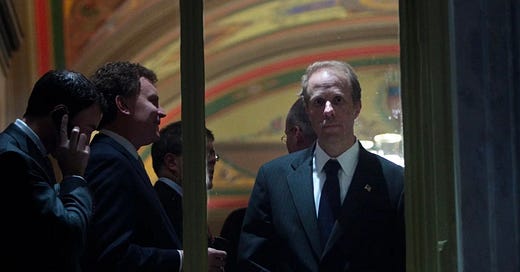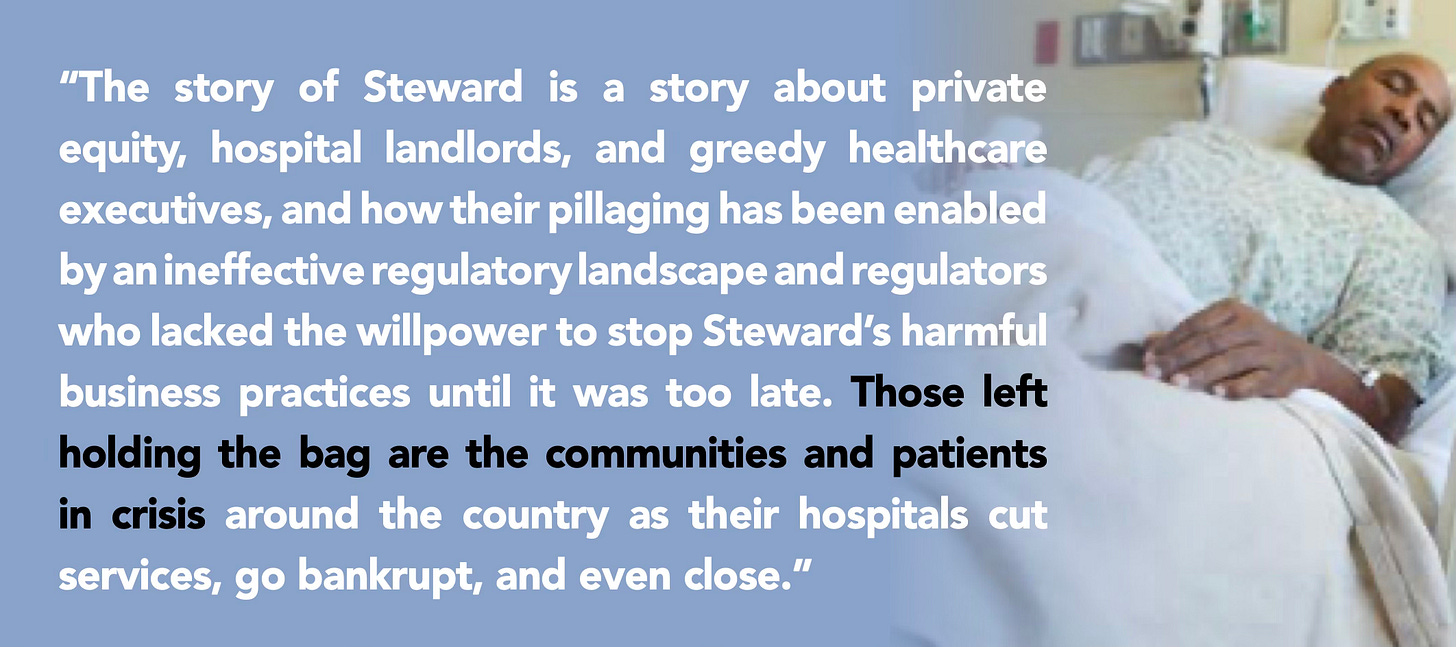United States President-elect asks Ruthless Private Equity Co-CEO Stephen Feinberg to be Deputy Defense Secretary
Cerberus Capital Management Co-CEO has long track record of harming Public Health | December 5, 2024 | Private Equity Stakeholders Group
(Photo: Stephen A. Feinberg by Brendan Smialowski for The New York Times.)
ON MAY 6, 2024, STEWARD HEALTH CARE, a 31-hospital system operating in 10 states, employing nearly 30,000 workers, and serving over 2 million patients annually, filed for Chapter 11 bankruptcy. The bankruptcy announcement came after months of media and regulatory attention around the health system’s deteriorating finances and associated patient care crisis.
In the months leading up to the bankruptcy, multiple stories appeared in media outlets highlighting Steward’s many issues, including unpaid vendors, supply shortages, understaffing, repossessed medical equipment, service cuts, and hospital closures.
In Florida, one Steward hospital was infested with thousands of bats including on the floor that housed the intensive care unit (ICU). The exterminator hired to address the issue sued the hospital months later alleging Steward had $1.6 million in unpaid bills.
In Massachusetts, a woman who gave birth at a Steward hospital died after the embolization coil needed to stop a bleed following childbirth was unavailable. The hospital’s supply of embolization coils had been repossessed by the company that owned them because Steward had not paid its bill.
At Steward’s Glenwood Regional Medical Center in West Monroe, Louisiana, health inspectors cited the hospital for putting patients in immediate jeopardy three times since December 2023.
In March 2024, the hospital closed down its inpatient rehabilitation unit. Federal inspectors found that the hospital ran out of multiple supplies including biopsy needles, catheters, and central lines.
Various radiology and imaging equipment were broken and in need of repair, and special beds that help prevent bedsores were repossessed.
As the patient care crisis occurring across multiple Steward hospitals garnered national attention, journalists and politicians were asking questions about Steward’s finances and the Private Equity involved.
How could a health system in the United States harm so many patients and ethical medical professionals so spectacularly? The short answer is disgraced (now resigned) Steward Health CEO Ralph De la Torre and Cerberus Capital Management’s Stephen Feinberg. The more sophisticated answer lies in corporate greed and a U.S. Congress that allows for-profit businesses and investors to loot hospitals. Who pays the price? Patients, medical care professionals, and the communities that these hospitals serve.
On May 6, 2024, Steward finally filed for Chapter 11 bankruptcy. Steward’s bankruptcy is one of the largest hospital bankruptcies in decades, with the system reporting over $9 billion in liabilities, including $290 million in unpaid employee wages and benefits, nearly $1 billion in unpaid bills to vendors and suppliers, and $6.6 billion in long-term rent obligations to its landlord, Medical Properties Trust.
(At a Senate hearing about the bankrupt, private equity-owned Steward Health Care, employees in the company’s hospitals described "tragic" conditions. The Boston Globe's Spotlight investigative team first reported on the allegations of neglect happening in Steward hospitals.)
How did Cerberus Capital Management legally siphon money out of Steward’s hospitals and harm patients while imposing moral injury on ethical medical professionals desperate to Do No Harm? Here’s the Harm-for-Profit playbook and Torch & Burn Private Equity timeline used by Cerberus Capital Management:
Steward Health Care is a multi-state hospital system that was owned by private equity firm Cerberus Capital Management from 2010 to 2020.
Steward formed in 2010 when Cerberus purchased Caritas Christi, a nonprofit Catholic health system in Massachusetts consisting of six hospitals. CEO Ralph de la Torre helped facilitate the no-bid deal with Cerberus that Massachusetts regulators ultimately approved despite community opposition.
Massachusetts regulators imposed conditions on the transaction and a five-year monitoring period for Steward following the transaction. Despite these guardrails, Steward’s financial situation declined from 2012 onward as its liabilities increased and Steward began asset stripping the system.
In 2016, after its monitoring period was over, Steward sold the real estate of its Massachusetts hospitals to Medical Properties Trust (MPT), a hospital landlord. This transaction generated $1.2 billion for Steward and its investors. Cerberus used the revenue to finance a $484 million dividend to one of its funds. The hospitals no longer owned their real estate and would be on the hook for millions of dollars in lease payments for years to come.
In 2017, with financing from MPT, Steward rapidly expanded from an 11-hospital system confined to Massachusetts to a 37-hospital system operating in 10 states. It became the largest for-profit private hospital operator in the US.
Many Steward hospitals were financially struggling as Cerberus began to make its exit in 2020. Ultimately, its exit was made possible by MPT, which provided a $335 million loan to a new set of physician owners and made a $400 million cash infusion into the struggling system at Cerberus’ behest.
In 2022, MPT brought in another investor, Macquarie Asset Management, which now owns fifty percent of Steward’s hospital real estate in eight Massachusetts hospitals. The recapitalization transaction that formed the Macquarie and MPT joint venture was funded with a $920 million loan from Apollo Global Management and two of its affiliates, Athene Life and Annuities and Aspen Insurance Holdings, which secured the loan with the eight hospitals.
In 2023, it was becoming apparent that Steward hospitals were on a path of financial distress, with missed rent payments, mounting patient care issues, and reports of unpaid bills to vendors. That year, Steward took on $600 million more in debt to refinance debt it already had.
Since 2018, Steward has closed six hospitals in the US, resulting in the layoffs of at least 2,650 workers and reduced access to care for the communities they served. Steward has also cut important service lines, such as obstetrics, behavioral health, and cancer care, at others. Two of the hospital closures happened in 2024 when the health system was on the eve of bankruptcy.
On May 6, 2024, Steward Health Care filed for Chapter 11 bankruptcy, reporting over $9 billion in liabilities. $6.6 billion of its reported liabilities are long-term lease liabilities owed to Medical Properties Trust.
Steward hospitals are at imminent risk for closure if there are no bidders at upcoming auctions. Experts predict it will be hard for MPT to find new tenants in hospitals with extensive lease liabilities.
Cerberus reportedly made $800 million in the decade it owned Steward. Around the time of Cerberus’ exit, Steward paid its ownership a $111 million dividend, including its CEO from its founding in 2010, Ralph de la Torre. Not long after, de la Torre bought a $40 million yacht. The company also bought two private jets and a private suite at Dallas’ AA arena.
Now, Stephen Feinberg may become the United States deputy secretary of defense, responsible for more than 700 Department of Defense medical, dental, and veterinary hospitals and the lives of 1.3 million active duty military personnel.
ADDITIONAL READING
Read more about the CEO of Cerberus from our friends at The Private Equity Stakeholder Group





